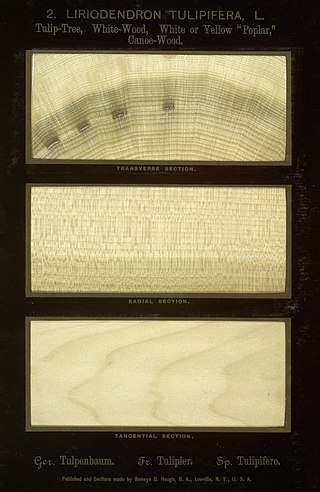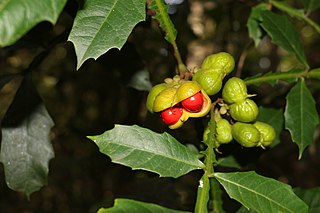
Most commonly, tulipwood is the greenish yellowish wood yielded from the tulip tree, found on the Eastern side of North America and a similar species is found in some parts of China. In the United States, it is commonly known as tulip poplar or yellow poplar, even though the tree is not related to the poplars. It is notable for its height, which can exceed 190 feet. The wood is very light, around 490 kg per cubic meter, but very strong and is used in many applications, including furniture, joinery and moldings. It can also be stained very easily and is often used as a low-cost alternative to walnut and cherry in furniture and doors.

Harpullia is a genus of about 27 species of small to medium-sized rainforest trees from the family Sapindaceae. They have a wide distribution ranging from India eastwards through Malesia, Papuasia and Australasia to the Pacific Islands. They grow naturally usually in or on the margins of rainforests or associated vegetation. Plants in the genus Harpullia are usually dioecious shrubs or trees covered with simple or star-shaped hairs. The leaves are paripinnate and the flowers are usually arranged in leaf axils, usually with 5 petals, 5 to 8 stamens and a 2-locular ovary. The fruit is a 2-lobed capsule.

Pleiogynium timoriense, commonly known as the Burdekin plum, sweet plum, tulip plum, or in the Djabugay language guybalum, is a medium-sized fruit-bearing tree in the cashew and mango family Anacardiaceae native to Malesia, Australia and the Pacific Islands.

Zanthoxylum brachyacanthum, known as thorny yellow-wood, satinwood, satin tree or scrub mulga, is a species of flowering plant in the family Rutaceae and is endemic to north-eastern Australia. It is a rainforest shrub or tree with thick, cone-shaped spines on the trunk and prickles on the branches, pinnate leaves, and male and female flowers arranged in panicles.

Cupaniopsis anacardioides, commonly known as tuckeroo, cashew-leaf cupania, carrotwood, beach tamarind or green-leaved tamarind, is a species of flowering plant in the family, Sapindaceae, and is native to eastern and northern Australia. It is a tree with paripinnate leaves with 4 to 8 egg-shaped leaflets with the narrower end towards the base, or elliptic leaves, and separate male and female flowers arranged in panicles, the fruit a more or less spherical golden yellow capsule.

Flindersia bennettii, commonly known as Bennett's ash, is a species of tree in the family Rutaceae and is endemic to north-eastern Australia. It has pinnate leaves with between three and nine leaflets, cream-coloured flowers arranged on the ends of branchlets and woody fruit containing winged seeds.

Cupaniopsis newmanii, commonly known as long-leaved tuckeroo, is a species of flowering tree in the soapberry family and is endemic to eastern Australia. It is a rainforest tree with paripinnate leaves with 16 to 24 narrowly egg-shaped to elliptic leaflets, and separate male and female flowers arranged in panicles, the fruit a rust-coloured capsule flushed with pink.

Harpullia frutescens, commonly known as dwarf harpullia, is a species of flowering plant in the family Sapindaceae, and is endemic to North Queensland. It is a shrub with paripinnate leaves with 6 to 8 leaflets, white flowers with a pink tinge, and crimson capsules containing 2 seeds with a yellow aril.

Cupaniopsis wadsworthii, sometimes commonly named duckfoot, or dwarf tuckeroo, is a species of flowering plant in the soapberry family and is endemic to Queensland. It is a slender shrub or small tree with paripinnate leaves with two to eight broadly wedge-shaped or broadly lobed leaflets, and separate male and female flowers arranged in raceme-like thyrses, the fruit a capsule with a seed with an orange aril.

Harpullia arborea, commonly known as Cooktown tulipwood in Australia, is species of flowering plant in the family Sapindaceae is native to the Indian subcontinent, Sri Lanka throughout Mainland Southeast Asia and Malesia to Queensland in Australia and the Western Pacific. It is a tree with paripinnate leaves with 6 to 10 leaflets, small pink or pale green flowers arranged in leaf axils or on old woody stems, and orange-yellow to red capsules containing shiny black seeds.

Harpullia hillii, commonly known as tulipwood, blunt-leaved tulip or oblong-leaved tulip, is a species of flowering plant in the family Sapindaceae, and is endemic to eastern Australia. It is a tree with paripinnate leaves, the leaflets elliptic to egg-shaped and papery with the narrower end towards the base, white flowers, and orange capsules containing a seed nearly enclosed in a red aril.

Harpullia alata, commonly known as winged tulip or wing-leaved tulip, is a species of flowering plant in the family Sapindaceae, and is endemic to eastern Australia. It is a tree with paripinnate leaves, the leaflets elliptic with teeth on the edges, white flowers and capsules containing a seed with a yellow to reddish aril.

Harpullia leichhardtii is a species of flowering plant in the family Sapindaceae, and is endemic to the Northern Territory. It is a tree with 4 to 8 paripinnate leaves, the leaflets oblong to elliptic, curved and papery, greenish-yellow flowers, and yellow-orange capsules.

Flindersia bourjotiana, commonly known as Queensland silver ash, northern silver ash, or white ash, is a species of tree that is endemic to Queensland. It has pinnate leaves arranged in opposite pairs and with between four and eight narrow egg-shaped to elliptic leaflets, greenish white flowers arranged in panicles, and fruit studded with short, rough points.

Harpullia ramiflora, commonly known as the Claudie tulipwood or Cape York tulipwood, is a tree in the Sapindaceae family native to north east Queensland, New Guinea and parts of Malesia.

Cupaniopsis dallachyi is a species of flowering plant in the soapberry family and is endemic to north-east Queensland. It is a tree with paripinnate leaves with 4 to 14 elliptic to egg-shaped leaflets with domatia along the midrib, separate male and female flowers arranged in panicles, the fruit a brown capsule containing a reddish-brown seed with a brown aril.
Cupaniopsis papillosa, commonly known as Tully Falls tamarind, is a species of flowering plant in the soapberry family and is endemic to a restricted area near Ravenshoe. It is a shrub or small tree with paripinnate leaves with 5 to 7 elliptic, egg-shaped or lance-shaped leaves with the narrower end towards the base, separate male and female, white flowers arranged in panicles, the fruit a fawn-yellow capsule.

Cupaniopsis serrata, commonly known as smooth tuckeroo, is a species of flowering plant in the soapberry family and is endemic to eastern Australia. It is a tree with paripinnate leaves with 6 to 12 oblong to egg-shaped leaflets with a pointed tip, and separate male and female flowers arranged in racemes, the fruit a more or less spherical capsule containing a seed with an orange aril.

Cupaniopsis simulata, commonly known as northern tuckeroo, is a species of flowering plant in the soapberry family and is endemic to eastern Queensland. It is a rainforest tree with paripinnate leaves with 4 to 12 elliptic leaflets, and separate male and female flowers arranged in a thyrse, the fruit a brownish orange capsule.

Cupaniopsis tomentella, commonly known as Boonah tuckeroo, is a species of flowering plant in the soapberry family and is endemic to south-eastern Queensland. It is a tree with paripinnate leaves with usually 6 to 8 elliptic or oblong leaflets, and separate male and female flowers arranged in a panicle, the fruit an orange-yellow capsule with a red flush.





















